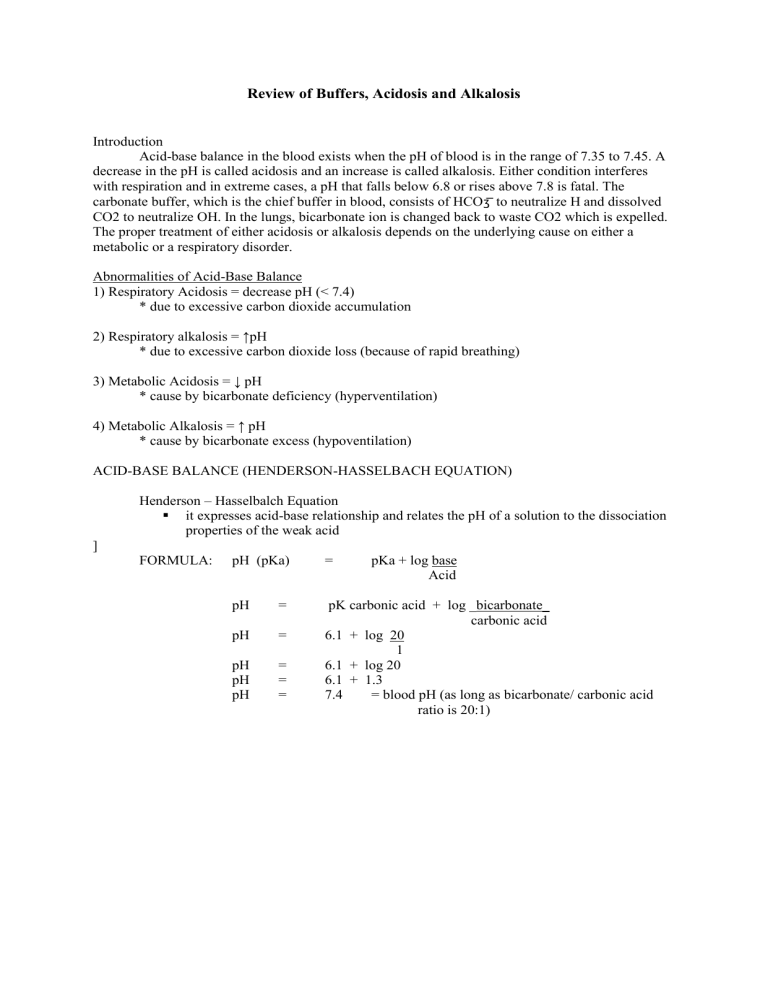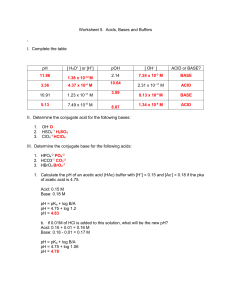
Review of Buffers, Acidosis and Alkalosis Introduction Acid-base balance in the blood exists when the pH of blood is in the range of 7.35 to 7.45. A decrease in the pH is called acidosis and an increase is called alkalosis. Either condition interferes with respiration and in extreme cases, a pH that falls below 6.8 or rises above 7.8 is fatal. The carbonate buffer, which is the chief buffer in blood, consists of HCOӡ ̅ to neutralize H and dissolved CO2 to neutralize OH. In the lungs, bicarbonate ion is changed back to waste CO2 which is expelled. The proper treatment of either acidosis or alkalosis depends on the underlying cause on either a metabolic or a respiratory disorder. Abnormalities of Acid-Base Balance 1) Respiratory Acidosis = decrease pH (< 7.4) * due to excessive carbon dioxide accumulation 2) Respiratory alkalosis = ↑pH * due to excessive carbon dioxide loss (because of rapid breathing) 3) Metabolic Acidosis = ↓ pH * cause by bicarbonate deficiency (hyperventilation) 4) Metabolic Alkalosis = ↑ pH * cause by bicarbonate excess (hypoventilation) ACID-BASE BALANCE (HENDERSON-HASSELBACH EQUATION) Henderson – Hasselbalch Equation it expresses acid-base relationship and relates the pH of a solution to the dissociation properties of the weak acid ] FORMULA: pH (pKa) = pKa + log base Acid pH = pH = pH pH pH = = = pK carbonic acid + log _bicarbonate_ carbonic acid 6.1 + log 20 1 6.1 + log 20 6.1 + 1.3 7.4 = blood pH (as long as bicarbonate/ carbonic acid ratio is 20:1) Buffer Solution Objectives: 1. To understand the nature of buffer solution 2. Understanding the buffer capacity 3. To learn how to prepare buffer solution Nature of Buffer Solution A buffer is a combination of a weak acid or weak base and its salt, is a system that resists changes in pH. The change in pH depends upon the addition of limited amounts of acid or base. It resists pH changes when it’s two components are present in specific proportions. A buffer is best used close to its pKa ( pKa = - logKa). It relates the Ka of a weak acid, HA and the pH of a solution of the weak acid. The Henderson–Hasselbalch equation is derived from the acid dissociation constant equation by the following steps: Ka= [H+][A-] /[HA] Rearranging the equation to solve for [ H+ ]; 1/[H+]=1/[Ka]*[A-]/[HA] By definition, log 1/ [H+] = pH , and log 1/Ka = pKa , so that by taking the log of the equation above, we get the Henderson–Hasselbalch equation; pH = pKa + log __(A)__ (HA) Buffers resist pH changes because they use up excess hydrogen ion or hydroxide ion. If we have a solution with both weak acid and its salt, and we add some H+ then the following reaction occurs: A- +H+ ↔ HA Conversely, if we added OH- the following occurs: HA+OH- ↔ A-+H2O Thus a buffer can protect against pH changes from added H+ or OH- ion as long as there is sufficient basic and acidic forms respectively. As soon as you run out of one of the forms you no longer have a buffer. To act as a good buffer the pH of the solution must be within one pH unit of the pKa. Buffer Capacity Buffers are solutions that can resist changes in pH upon addition of small amounts of acid or base. Quantitative measure of this resistance to pH changes is called buffer capacity. Buffer capacity can be defined in many ways, it can be defined as the number of moles of H+/OH- ions that must be added to one liter of the buffer in order to decrease or increase the pH by one unit respectively. Common buffer mixtures contain two substances, a conjugate acid and a conjugate base, they resist large changes in pH by absorbing the H+ ions or OH- ions added to the system. When H+ ions are added to the system they will react with the conjugate base in the buffer as follows, H+ + A- HA When OH- ions are added they will react with the conjugate acid in the buffer as follows, OH- + HA A- + H2O Thus the buffer is effective as long as it does not run out of one of its components. Name: ____________________________ Course/ Year/ Section/ Group: _________ MC 2 (Lab) Date: ____________ Rating: Experiment No. 1 Preparation of Phosphate Buffer Objective: 1. Students would be able to learn how to prepare buffer solution. 2. Study the properties of buffer solution Materials: Two beakers 50ml Glass spatula for mixing pH meter to measure the pH Phosphate buffer pH=7.4 (prepared) Hydrochloric acid with 0.1M (HCl) Sodium hydroxide with 0.1M (NaOH) Methods/ Procedure: A. Preparation of Phosphate Buffer Prepare 500ml from phosphate buffer with concentration 0.25M and pH= 7.4, if you know that (pKa=7.2) 1. Buffer solution content, which are * Monosodium dihydrogen phosphate (NaH2PO4) * Disodium hydrogen phosphate (Na2HPO4) 2. Calculation of the Acid and conjunct base percentage by using Henderson equation: pH = pKa+ log [A-] [HA] 7.4 = 7.2+ log [A-] [HA] 7.4 - 7.2 = log [A-]_ [HA] 0.2 = log [A-] [HA] Na2HPO4 /NaH2PO4 = 1.6 The percentage is 1.6:1 which means these component mixed as per as this percentage will have buffer solution with pH=7.4 which the pH we want. 3. Calculate the weight for both compounds: We calculate the weight by using equation: wg= Number of mols x Molecular weight x 100 / 1000 for both Monosodium dihydrogen phosphate and Disodium hydrogen phosphate. 4. Dissolve both component in 250ml distilled water in beaker 5. pH will measured by pH meter which will be around 7.4 however to get the exact pH by adding those amounts of acid (HCl) or base (NaOH) 6. All of these amounts will placed in volumetric flask there we complete to the final volume 500ml by adding distilled water. B. Studying the properties of buffer solution 1. Put 40ml of distilled water in beaker (A) and in another Beaker (B) put 40ml from phosphate buffer that we’re previously prepared. 2. Both beaker consonant will measure pH by using pH meter 3. Add to both particular amount of hydrochloric acid or sodium hydroxide and mix it gently 4. Measure the hydrogen number pH for both beakers again. 5. Write down your observation in the table below. Results: Volume of HCl 0.1M pH value for phosphate buffer after the addition pH value for water after the addition pH value for phosphate buffer after the addition pH value for water after the addition 0.5 ml 1 ml 2 ml pH after the addition Volume of NaOH 0.1M 0.5 ml 1 ml 2 ml pH after the addition Conclusion:




